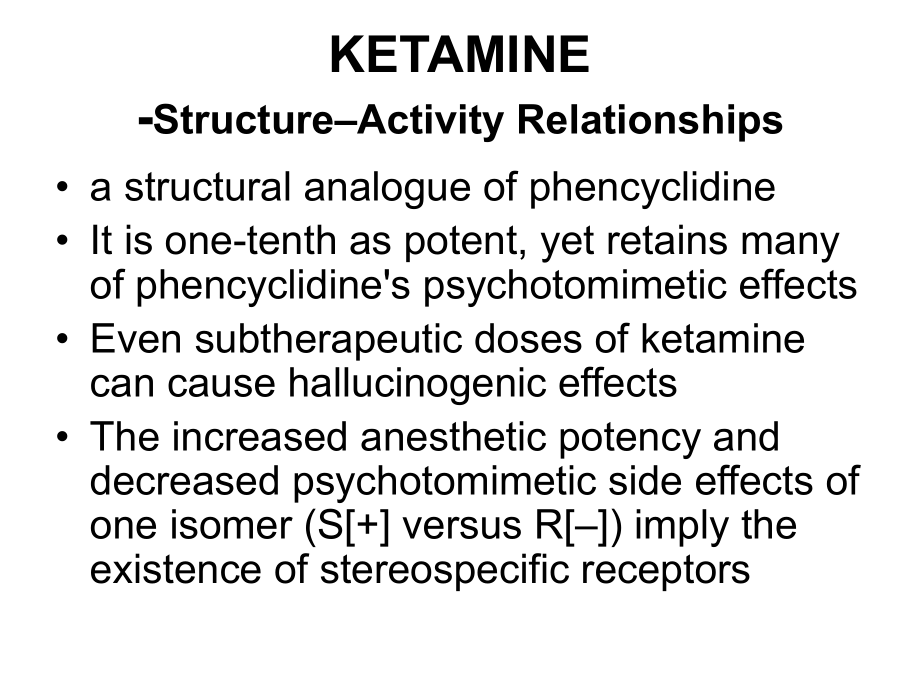




版权说明:本文档由用户提供并上传,收益归属内容提供方,若内容存在侵权,请进行举报或认领
文档简介
1、氯氨酮和依托咪酯钟静KETAMINE Mechanisms of Action multiple effects on the central nervous system blocking polysynaptic reflexes in the spinal cord inhibiting excitatory neurotransmitter effects in selected areas of the brain KETAMINE-Mechanisms of Action functionally dissociates the thalamus from the limbic c
2、ortex the thalamus: which relays sensory impulses from the reticular activating system to the cerebral cortex the limbic cortex: which is involved with the awareness of sensation this state of dissociative anesthesia causes the patient to appear conscious (eg, eye opening, swallowing, muscle contrac
3、ture) but unable to process or respond to sensory input KETAMINE-Mechanisms of Action an N-methyl-D-aspartate receptor antagonist The existence of specific ketamine receptors and interactions with opioid receptors has been postulated KETAMINE-StructureActivity Relationships a structural analogue of
4、phencyclidine It is one-tenth as potent, yet retains many of phencyclidines psychotomimetic effects Even subtherapeutic doses of ketamine can cause hallucinogenic effects The increased anesthetic potency and decreased psychotomimetic side effects of one isomer (S+ versus R) imply the existence of st
5、ereospecific receptors KETAMINE-Pharmacokinetics Absorption: administered intravenously or intramuscularly Peak plasma levels are usually achieved within 1015 min after intramuscular injection Distribution: more lipid soluble and less protein bound than thiopental equally ionized at physiological pH
6、 lead to rapid brain uptake and subsequent redistribution (the distribution half-life is 1015 min) awakening is due to redistribution to peripheral compartments KETAMINE-Pharmacokinetics Biotransformation in the liver some of which (eg, norketamine) retain anesthetic activity Induction of hepatic en
7、zymes may lead to the tolerance in patients who receive multiple doses of ketamine EXCRETION By kidneyKETAMINE -Effects on Organ Systems Cardiovascular indirect cardiovascular effects: increase arterial blood pressure, heart rate, and cardiac output due to central stimulation of the sympathetic nerv
8、ous system and inhibition of the reuptake of norepinephrine increase in pulmonary artery pressure and myocardial work avoided in patients with coronary artery disease, uncontrolled hypertension, congestive heart failure, and arterial aneurysms are often beneficial to patients with acute hypovolemic
9、shock KETAMINE -Effects on Organ Systems direct cardiovascular effects myocardial depressant effects of large doses of ketamine due to inhibition of calcium transients are unmasked by sympathetic blockade (eg, spinal cord transection) or exhaustion of catecholamine stores (eg, severe end-stage shock
10、)KETAMINE -Effects on Organ Systems Respiratory Ventilatory drive is minimally affected by the customary induction doses of ketamine rapid intravenous bolus administration or pretreatment with opioids occasionally produces apnea a potent bronchodilator, making it a good induction agent for asthmatic
11、 patients Although upper airway reflexes remain largely intact, patients at increased risk for aspiration pneumonia should be intubated The increased salivation associated with ketamine can be attenuated by premedication with an anticholinergic agent KETAMINE -Effects on Organ Systems Cerebral incre
12、ase cerebral oxygen consumption, cerebral blood flow, and intracranial pressure preclude in patients with space-occupying intracranial lesions psychotomimetic side effects (eg, illusions, disturbing dreams, and delirium) during emergence and recovery are less common in children and in patients preme
13、dicated with benzodiazepines KETAMINE Of the nonvolatile agents, ketamine may be the closest to being a complete anesthetic as it induces analgesia, amnesia, and unconsciousness KETAMINE-Drug Interactions Nondepolarizing neuromuscular blocking agents are potentiated by ketamine The combination of th
14、eophylline and ketamine may predispose patients to seizures Diazepam attenuates ketamines cardiostimulatory effects and prolongs its elimination half-life KETAMINE-Drug Interactions Propranolol, phenoxybenzamine, and other sympathetic antagonists unmask the direct myocardial depressant effects of ke
15、tamine Ketamine produces myocardial depression when given to patients anesthetized with halothane or, to a lesser extent, other volatile anesthetics Lithium may prolong the duration of action of ketamineETOMIDATEETOMIDATE-Mechanisms of Action depress the reticular activating system and mimics the in
16、hibitory effects of GABA etomidate (particularly the R+ isomer) appears to bind to a subunit of the GABA type A receptor, increasing its affinity for GABA Unlike barbiturates, it may have disinhibitory effects on the parts of the nervous system that control extrapyramidal motor activity This disinhi
17、bition is responsible for a 3060% incidence of myoclonus ETOMIDATE-StructureActivity Relationships contain a carboxylated imidazole, is structurally unrelated to other anesthetic agents The imidazole ring provides water solubility in acidic solutions and lipid solubility at physiological pH dissolve
18、d in propylene glycol-This solution often causes pain on injection that can be lessened by a prior injection of lidocaine ETOMIDATE-Pharmacokinetics Absorption available only for intravenous administration and is used primarily for induction of general anesthesia Distribution Although it is highly p
19、rotein bound, etomidate is characterized by a very rapid onset of action due to its high lipid solubility and large nonionized fraction at physiological pH Redistribution is responsible for decreasing the plasma concentration to awakening levels ETOMIDATE-Pharmacokinetics Biotransformation Hepatic m
20、icrosomal enzymes and plasma esterases rapidly hydrolyze etomidate to an inactive metabolite The rate of biotransformation is five times greater for etomidate than for thiopental Excretion By kidneyETOMIDATE-Effects on Organ Systems Cardiovascular Etomidate has minimal effects on the cardiovascular
21、system A mild reduction in peripheral vascular resistance is responsible for a slight decline in arterial blood pressure Myocardial contractility and cardiac output are usually unchanged Etomidate does not release histamine ETOMIDATE-Effects on Organ Systems Respiratory Ventilation is affected less
22、with etomidate than with barbiturates or benzodiazepines Even induction doses usually do not result in apnea unless opioids have also been administered ETOMIDATE-Effects on Organ Systems Cerebral decrease the cerebral metabolic rate, cerebral blood flow, and intracranial pressure to the same extent as thiopental
温馨提示
- 1. 本站所有资源如无特殊说明,都需要本地电脑安装OFFICE2007和PDF阅读器。图纸软件为CAD,CAXA,PROE,UG,SolidWorks等.压缩文件请下载最新的WinRAR软件解压。
- 2. 本站的文档不包含任何第三方提供的附件图纸等,如果需要附件,请联系上传者。文件的所有权益归上传用户所有。
- 3. 本站RAR压缩包中若带图纸,网页内容里面会有图纸预览,若没有图纸预览就没有图纸。
- 4. 未经权益所有人同意不得将文件中的内容挪作商业或盈利用途。
- 5. 人人文库网仅提供信息存储空间,仅对用户上传内容的表现方式做保护处理,对用户上传分享的文档内容本身不做任何修改或编辑,并不能对任何下载内容负责。
- 6. 下载文件中如有侵权或不适当内容,请与我们联系,我们立即纠正。
- 7. 本站不保证下载资源的准确性、安全性和完整性, 同时也不承担用户因使用这些下载资源对自己和他人造成任何形式的伤害或损失。
最新文档
- 2025年机械制造行业技术升级合作合同
- 二零二五年度装配式建筑构件设计、制造与施工合同
- 二零二五年成都多层二手房买卖协议书
- 2025年水利工程用挡土墙设计与施工合同
- 二零二五年度城市绿化景观EPC总承包项目合同协议
- 2025年度集装箱车辆货物运输及仓储管理合同
- 二零二五年度特色民宿二手房买卖预付款合同规范
- 二零二五年度商务区临时租赁及物业管理合同
- 2025年度地铁隧道工程建设项目施工合同正规范本
- 二零二五年物流配送网络优化服务承包协议
- (高清版)DB36∕T 1324-2020 公路建设项目档案管理规范
- 深基坑开挖专项安全监理实施细则方案(2篇)
- 2025年八省联考新高考 语文试卷
- 对赌融资协议书范文范本
- 国家开放大学《Web开发基础》形考任务实验1-5参考答案
- 《进一步规范管理燃煤自备电厂工作方案》发改体改〔2021〕1624号
- 中等职业技术学校人工智能技术应用专业(三年制)人才培养方案
- 箱式变电站技术规范书
- 高考数学专项练习极值点偏移问题
- 健康教育指导评分表
- Q-GDW 12105-2021电力物联网数据中台服务接口规范

评论
0/150
提交评论